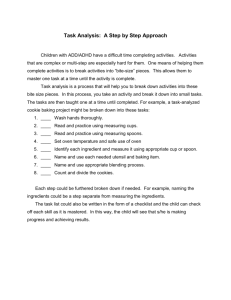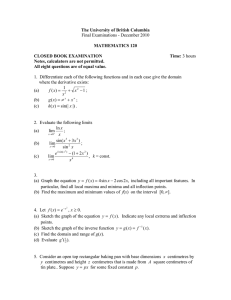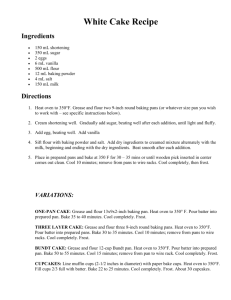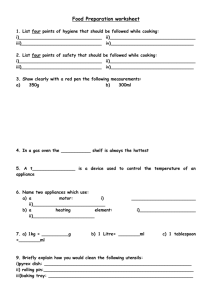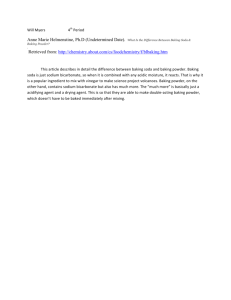Advance Journal of Food Science and Technology 8(10): 747-750, 2015
advertisement
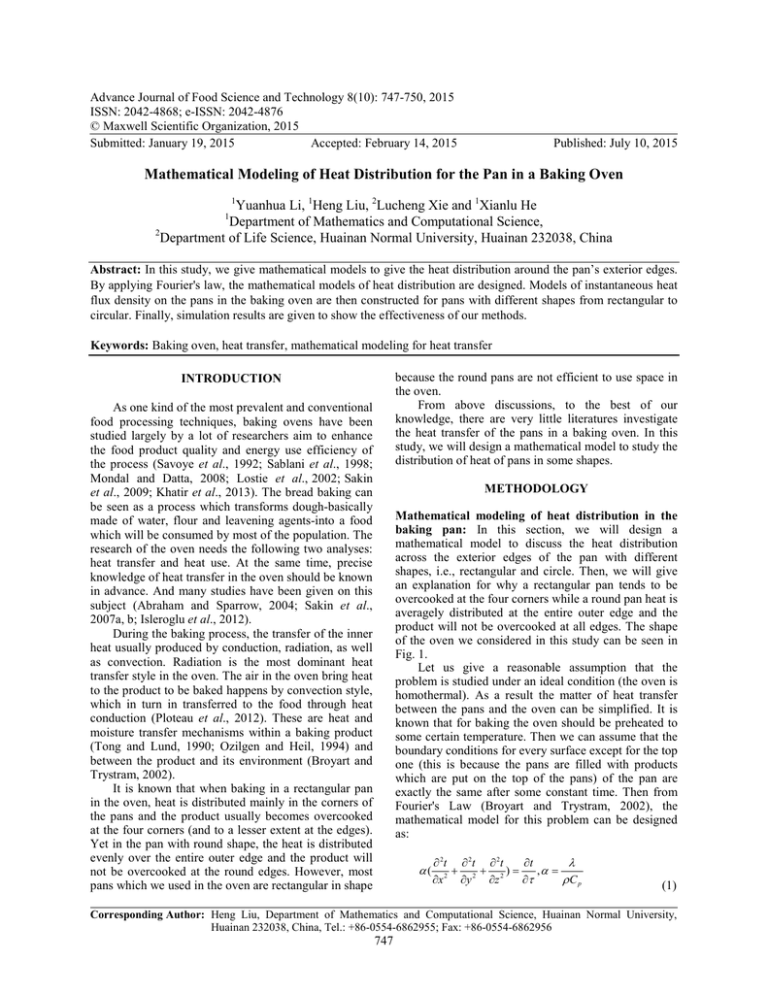
Advance Journal of Food Science and Technology 8(10): 747-750, 2015 ISSN: 2042-4868; e-ISSN: 2042-4876 © Maxwell Scientific Organization, 2015 Submitted: January 19, 2015 Accepted: February 14, 2015 Published: July 10, 2015 Mathematical Modeling of Heat Distribution for the Pan in a Baking Oven 1 Yuanhua Li, 1Heng Liu, 2Lucheng Xie and 1Xianlu He Department of Mathematics and Computational Science, 2 Department of Life Science, Huainan Normal University, Huainan 232038, China 1 Abstract: In this study, we give mathematical models to give the heat distribution around the pan’s exterior edges. By applying Fourier's law, the mathematical models of heat distribution are designed. Models of instantaneous heat flux density on the pans in the baking oven are then constructed for pans with different shapes from rectangular to circular. Finally, simulation results are given to show the effectiveness of our methods. Keywords: Baking oven, heat transfer, mathematical modeling for heat transfer because the round pans are not efficient to use space in the oven. From above discussions, to the best of our knowledge, there are very little literatures investigate the heat transfer of the pans in a baking oven. In this study, we will design a mathematical model to study the distribution of heat of pans in some shapes. INTRODUCTION As one kind of the most prevalent and conventional food processing techniques, baking ovens have been studied largely by a lot of researchers aim to enhance the food product quality and energy use efficiency of the process (Savoye et al., 1992; Sablani et al., 1998; Mondal and Datta, 2008; Lostie et al., 2002; Sakin et al., 2009; Khatir et al., 2013). The bread baking can be seen as a process which transforms dough-basically made of water, flour and leavening agents-into a food which will be consumed by most of the population. The research of the oven needs the following two analyses: heat transfer and heat use. At the same time, precise knowledge of heat transfer in the oven should be known in advance. And many studies have been given on this subject (Abraham and Sparrow, 2004; Sakin et al., 2007a, b; Isleroglu et al., 2012). During the baking process, the transfer of the inner heat usually produced by conduction, radiation, as well as convection. Radiation is the most dominant heat transfer style in the oven. The air in the oven bring heat to the product to be baked happens by convection style, which in turn in transferred to the food through heat conduction (Ploteau et al., 2012). These are heat and moisture transfer mechanisms within a baking product (Tong and Lund, 1990; Ozilgen and Heil, 1994) and between the product and its environment (Broyart and Trystram, 2002). It is known that when baking in a rectangular pan in the oven, heat is distributed mainly in the corners of the pans and the product usually becomes overcooked at the four corners (and to a lesser extent at the edges). Yet in the pan with round shape, the heat is distributed evenly over the entire outer edge and the product will not be overcooked at the round edges. However, most pans which we used in the oven are rectangular in shape METHODOLOGY Mathematical modeling of heat distribution in the baking pan: In this section, we will design a mathematical model to discuss the heat distribution across the exterior edges of the pan with different shapes, i.e., rectangular and circle. Then, we will give an explanation for why a rectangular pan tends to be overcooked at the four corners while a round pan heat is averagely distributed at the entire outer edge and the product will not be overcooked at all edges. The shape of the oven we considered in this study can be seen in Fig. 1. Let us give a reasonable assumption that the problem is studied under an ideal condition (the oven is homothermal). As a result the matter of heat transfer between the pans and the oven can be simplified. It is known that for baking the oven should be preheated to some certain temperature. Then we can assume that the boundary conditions for every surface except for the top one (this is because the pans are filled with products which are put on the top of the pans) of the pan are exactly the same after some constant time. Then from Fourier's Law (Broyart and Trystram, 2002), the mathematical model for this problem can be designed as: α( ∂ 2t ∂ 2t ∂ 2t ∂t λ + 2 + 2)= ,α = 2 ∂x ∂ y ∂z ∂τ ρC p (1) Corresponding Author: Heng Liu, Department of Mathematics and Computational Science, Huainan Normal University, Huainan 232038, China, Tel.: +86-0554-6862955; Fax: +86-0554-6862956 747 Adv. J. Food Sci. Technol., 8(10): 747-750, 2015 Fig. 1: The baking oven and pans in different shapes where, α : The thermal diffusivity ρ and Cp : The density and the specific heat capacity λ : Heat transfer coefficient t : The temperature T ( x, p ) = C1e x T ( x,τ ) = 4π a + C2e x p a (4) ∫ τ 0 x2 f 0 (τ ' ) − 4α (τ −τ ' ) ' e dτ (τ − τ ' )3/2 (5) In which f0 (τ ) = t = ts − t0 , where ts is the boundary (2) temperature. Mathematical model of heat distribution in a rectangular pan: From above discussions, the equation of heat diffusion in a rectangular baking pan can be expressed as: By using the Laplace transformation, we can obtain: d 2 T ( x, p ) p − T ( x, p ) = 0 2 a dx T ( x, p ) | x = 0 = f 0 ( p ) lim T ( x, p ) = 0 x →0 p a From above discussions, we can design the heat transfer model as: The above model (1) can be simplified as: ∂ 2t ∂t α ∂x = ∂τ t ( x,τ ) | = f (τ ) x =0 lim t ( x,τ ) = t0 x→0 t ( x,τ ) |τ =0 = t0 x T ( x, y, z, t ) = a2 ∆T ( x, y, z, t ) (3) (6) The boundary conditions can be defined as: T ( x0 , y, z, t ) = T0 , T ( x1 , y, z, t ) = T0 T ( x, y0 , z, t ) = T0 , T ( x, y1 , z, t ) = T0 T ( x, y, z , t ) = T 0 0 As a result (4) can be solved as: 748 (7) Adv. J. Food Sci. Technol., 8(10): 747-750, 2015 Table 1: Parameter values in the computation of the model Variable Value A 0.02 a 0.10 ε 1.47×10-5 λ 54 However, the boundary condition for the upper surface of the baking pan is different. It can be defined as: ∂T =ε ∂n (8) Unit m2 m m2/sec w/ (m C°) With ε is a small enough constant. According to our assumption, the surface of the pan does not change, thus, the (8) can be rearranged as: Tz ( x, y, z, t ) = ε (9) And its initial condition can be given as: T ( x, y, z , 0) = T0 (10) Then we can design the final model of this case as: T (x, y, z, t) = a2∆T ( x, y, z, t) T (x0 , y, z, t) = T0 ,T ( x1, y, z, t) = T0 T (x, y0 , z, t) = T0 ,T ( x, y1, z, t) = T0 T (x, y, z , t) = T ,T (x, y, z , t) = ε 0 0 Z 1 T (x, y, z,0) = T0 Fig. 2: Instantaneous heat flux density of rectangular pan at different time (11) Mathematical model of heat distribution in a circle pan: As the same discussion in the rectangular case, the heat distribution model for a baking pan can be designed as: T (r, z, t ) = a2∆T (r, z, t ) T (r0 , z, t ) = T0 , T (r1, z, t ) = T0 T (r, z0 , t ) = T0 , T (r, z1, t ) = ε T (r, z,0) = 0 (12) SIMULATION RESULTS Fig. 3: Heat distribution at the outer edge of a rectangular baking pan To solve the mathematical models in above Section, we will consider several plausible methods. The commonly used methods are the Fourier transform method and traveling-wave method. Firstly we investigate the case that the pan has a rectangular shape. As the statement in Savoye et al. (1992), Sablani et al. (1998) and Sakin et al. (2009), in this study, the parameters in above mathematical models are chosen as Table 1 in the simulation. The simulation results are depicted in Fig. 2 and 3. It can be seen in Fig. 3 that the four corners is different from the other parts of the pan. And there are convex curves with a radiant at the four corners while the other parts are round-like closed curves expanding from the heart. This result is exactly in accordance with the real heat distribution of a rectangular pan has been verified by this model. Fig. 4: Instantaneous heat flux density of circular pan at different time 749 Adv. J. Food Sci. Technol., 8(10): 747-750, 2015 Isleroglu, H., T. Kemerli, M.S. Yilmazer, G. Guven, O. Ozdestan, A. Uren and F.K. Ertekin, 2012. Effect of steam baking on acrylamide formation and browning kinetics of cookies. J. Food Sci., 77(10): 257-263. Khatir, Z., H. Thompson, N. Kapur, V. Toropov and J. Paton, 2013. Multi-objective Computational Fluid Dynamics (CFD) design optimisation in commercial bread-baking. Appl. Therm. Eng., 60(1): 480-486. Lostie, M., R. Peczalski, J. Andrieu and M. Laurent, 2002. Study of sponge cake batter baking process. II. Modeling and parameter estimation. J. Food Eng., 55(4): 349-357. Mondal, A. and A.K. Datta, 2008. Bread baking: A review. J. Food Eng., 86(4): 465-474. Ozilgen, M. and J.R. Heil, 1994. Mathematical modelling of transient heat and mass transport in a baking process. J. Food Process. Pres., 18: 133-148. Ploteau, J.P., V. Nicolas and P. Glouannec, 2012. Numerical and experimental characterization of a batch bread baking oven. Appl. Therm. Eng., 48: 289-295. Sablani, S.S., M. Marcotte, O.D. Baik and F. Castaigne, 1998. Modeling of simultaneous heat and water transport in the baking process. Lebensm-Wiss. Technol., 31: 201-209. Sakin, M., F. Kaymak-Ertekin and C. Ilicali, 2007a. Modeling the moisture transfer during baking of white cake. J. Food Eng., 80: 822-831. Sakin, M., F. Kaymak-Ertekin and C. Ilicali, 2007b. Simultaneous heat and mass transfer simulation applied to convective oven cupcake baking. J. Food Eng., 83: 463-474. Sakin, M., F. Kaymak-Ertekin and C. Ilicali, 2009. Convection and radiation combined surface heat transfer coefficient in baking ovens. J. Food Eng., 94: 344-349. Savoye, I., G. Trystram, A. Duquenoy, P. Brunet and F. Marchin, 1992. Heat and mass transfer dynamic modeling of an indirect biscuit baking tunnel-oven. Part I: Modeling principles. J. Food Eng., 16: 173-196. Tong, C.H. and D.B. Lund, 1990. Effective moisture diffusivity in porous materials as a function of temperature and moisture content. Biotechnol. Progr., 6: 67-75. Fig. 5: Heat distribution at the outer edge of a circle baking pan Ten, consider the circular brownie pans, the simulation results are given in Fig. 4 and 5. From the figures we can also conclude that when the products are baked on the circular pan, the heat is distributed evenly over the entire outer edge. CONCLUSION In this study we have designed two mathematical models to show the heat distribution across the outer edge of a pan for pans with different shapesrectangular to circular. To show how heat distributes in a specific pan, the law of heat conduction for a threedimensional product is given to design our models for heat distribution. Then, finite difference methods are given to solve the proposed model. Finally simulation results are presented to show the effectiveness of our methods. ACKNOWLEDGMENT Project is supported by the Key Teaching Research Foundation of the Anhui Higher Education of China (Grant No. 2013JYXM187). REFERENCES Abraham, J.P. and E.M. Sparrow, 2004. A simple model and validating experiments for predicting the heat transfer to a load situated in an electrically heated oven. J. Food Eng., 62(4): 409-415. Broyart, B. and G. Trystram, 2002. Modelling heat and mass transfer during the continuous baking of biscuits. J. Food Eng., 51: 47-57. 750
